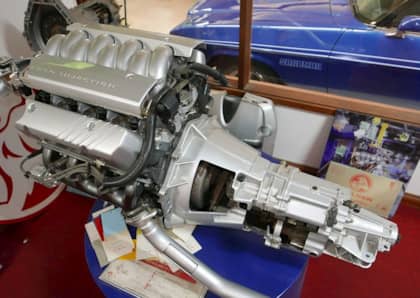The Muncie 4 Speed Transmission Taught A Generation Of Muscle Car Fans To Drive Manual
The Muncie 4-speed transmission is a legend among fans of GM muscle cars. For a 10 year period starting in the golden age of 1960s performance, General Motors' Muncie, Indiana transmission factory churned out several different flavors of this manual gearbox. This imprinted the name on the brains of drag racers and high performance fans after it was included with some of the hottest vehicles of the era.

The Muncie earned its keep by offering a better shifting experience than any other gearbox to date from Chevrolet, Pontiac, Oldsmobile, and Buick. It was no accident, either: the 4-speed was the product of careful engineering intended to modernize GM's transmission offerings, and it benefited from continual updates during its decade-long run as the go-to shift-it-yourself option.
Insourcing Its Outsourcing
In the early 1960s, GM was looking to move away from the four-speed manual transmissions it had been purchasing from BorgWarner and bring production in-house. The twist was the four-speed gearbox found in the first two generations of the Chevrolet Corvette—the BorgWarner T10—had in fact been built using plans supplied by a GM engineer named James Fodrea, based on the earlier BorgWarner 3-speed T85 gearbox. Unable to justify a small production run for the Vette program, GM had instead farmed out the T10, and the company borrowed as much as it could from the T85's internals to keep costs down (and eventually sold the transmission to GM's rivals at Chrysler and Ford).

The Muncie transmission and the T10 are visibly very similar, but it's the differences that would make GM's newcomer an enduring force for muscle fans. Once again Fodrea was involved, and a key aspect of the Muncie redesign involved strengthening the basic design of the T10 so that it could handle more torque without sacrificing the ability to shift smoothly.

Highlights included synchro cones that had been boosted in size, and after the first year of production (1963), a larger front bearing and bearing retainer, with a press-fit bushing for first gear. Over the years the casing would be reinforced, a larger countershaft was added, synchro rings were redesigned, and shifter shafts were changed to a bolt-on design. By the time the Muncie was in its final phase of production (1971-1974) it also gained a 32 spline output shaft in place of the original 27 spline unit.
Wide, Close, or Rock Crusher
Initially there were two specific Muncie transmissions available: the M20 wide-ratio (2.56:1 first gear) and the M21 close-ratio (2.20:1 first gear). The latter also offered a 1.64 second, 1.28 third, and direct-drive 1.00 fourth gear, making it the most popular choice for street racers (as a close-ratio design allowed drivers to run through the gears much more quickly while taking maximum advantage of a vehicle's power band).

In 1963, Chevrolet wanted to take the Corvette racing. To do so, it needed an even tougher gearbox than the M21, and while the Grand Sport never made it to Le Mans due to GM politics removing its brands from motorsports competition, the Bowtie brand was able to test the Muncie enough to develop a newer version that eventually hit the streets as the M22.

The M22 'Rock Crusher' featured a one-inch countershaft pin bore and shot-peened gears with aggressive helix angles that reduced heat and stress but also increased noise, leading to the nickname as the transmissions rattled their way down the road. The upside to the racket was the ability to hold even big block torque without worrying about grenading on the starting line.

From 1965-onwards the Rock Crusher was available with the Corvette, and by 1969 it was found on vehicles as diverse as the Chevelle, the Camaro, and the Oldsmobile 442. If a car made big power, chances are a Muncie M22 was on the menu.
Still A Strong Choice
Today, all three versions of the Muncie transmission remain a popular choice for both classic car restorations and hot rod builds. There are many different aftermarket companies out there that offer full, custom rebuilds for the M20, M21, and M22, and it's possible to get almost any gear set you want stuffed inside a Muncie casing.

It's also worth noting that Muncie casings are cheap and plentiful in salvage yards if you don't feel like buying new. The GM design is just as strong today as it was nearly 60 years ago, and that makes it the go-to gearbox for Chevy, Olds, Buick, and Pontiac fans looking for a period-correct muscle car transmission.











